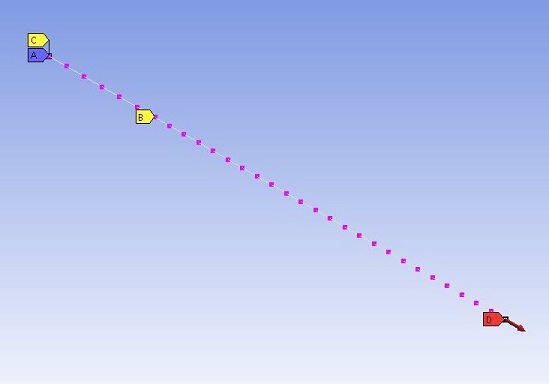VM-WB-MECH-088
VM-WB-MECH-088
Harmonic Response of a Guitar String
Overview
| Reference: | Blevins, R.D. (1979). Formulas for Natural Frequency and Mode Shape (p. 90, tab. 7-1). New York, NY: Nostrand Reinhold Co. |
| Solver(s): | Ansys Mechanical |
| Analysis Type(s): | Static Structural Linear Perturbed Modal Linear Perturbed Harmonic |
| Element Type(s): | Beam |
Test Case
A uniform stainless steel guitar string of length l and diameter d is stretched between two rigid supports by a tensioning force F1, which is required to tune the string to the E note of a C scale. The string is then struck near the quarter point with a force F2. Determine the fundamental frequency, f1. Also, show that only the odd-numbered frequencies produce a response at the midpoint of the string for this excitation.
This problem is also presented in VM76
in the Mechanical APDL Verification Manual.
| Material Properties | Geometric Properties | Loading | |||||||
|---|---|---|---|---|---|---|---|---|---|
|
|
|
Analysis Assumptions and Modeling Notes
Enough elements are selected so that the model can be used to adequately characterize the string dynamics. The stress stiffening capability of the elements is used. Linear perturbed harmonic analysis determines the displacement response to the lateral force F2.
Results Comparison
| Target | Mechanical | Error (%) | ||
|---|---|---|---|---|
| Modal | f, Hz | 322.2 | 322.67 | 0.15 |
| Frequency Response | f1, (322.2 Hz) | Response | Response, 320 < f < 328 | - |
| f2, (644.4 Hz) | No Response | No Response | - | |
| f3, (966.6 Hz) | Response | Response, 966 < f < 974 | - | |
| f4, (1288.8 Hz) | No Response | No Response | - | |
| f5, (1611.0 Hz) | Response | Response, 1611 < f < 1619 | - | |
| f6, (1933.2 Hz) | No Response | No Response | - | |




